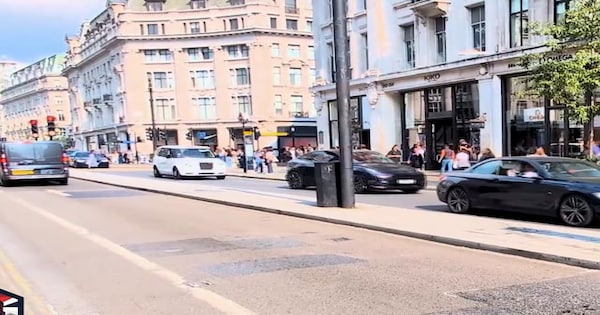The Impact of Banning Traffic on Oxford Street in London
London, one of the most popular tourist destinations in the United Kingdom, attracts over half a million visitors each day for various activities such as shopping, dining, and entertainment. Recently, London Mayor Sadiq Khan made an important announcement regarding the banning of traffic on Oxford Street. This decision is expected to have significant implications for the city’s economy, local businesses, and residents, including several British Indian individuals residing in the area.
Economic Implications
The ban on traffic on Oxford Street could have a substantial impact on the city’s economy. With an influx of tourists and locals drawn to this iconic shopping district every day, businesses in the area rely heavily on foot traffic for their revenue. The ban may lead to an increase in pedestrian activity and contribute to greater sales opportunities for these businesses. Additionally, it may also result in improved air quality due to reduced vehicular pollution.
Effects on Local Businesses
For shops and establishments located along Oxford Street and its vicinity, this development could bring about both positive and negative changes. While increased footfall may boost sales for retailers and restaurants by making them more accessible to pedestrians, it might also lead to logistical challenges regarding delivery services or attracting customers who prefer traveling by car. Moreover,
How does the traffic ban on Oxford Street aim to improve air quality in London?
On December 2018, a bold plan was announced to ban all traffic from the world-renowned Oxford Street in London. The move, which was enacted to improve air quality and reduce congestion, has sparked a significant amount of speculation regarding its potential impact on the British economy. In this article, we will delve into the potential implications of the traffic ban on Oxford Street and explore how it may affect various sectors of the economy.
Why the Traffic Ban?
The decision to ban traffic on Oxford Street stems from the need to address the air pollution crisis in London. Oxford Street has long been notorious for its high levels of pollution, which pose serious health risks to both residents and visitors. By banning traffic in the area, authorities hope to significantly reduce air pollution and create a more pleasant and healthy environment for the public.
Impact on Retail and Tourism
Oxford Street is renowned for its vibrant retail scene, attracting millions of shoppers from all over the world. With the traffic ban in place, the street is expected to become even more appealing to visitors, leading to an increase in foot traffic for retail businesses. As a result, retailers can expect a boost in sales and a heightened demand for their products. Similarly, the ban is likely to enhance the overall appeal of the area, making it a more attractive destination for tourists.
Transportation and Logistics
While the traffic ban may bring positive changes for retailers and tourists, it could pose challenges in terms of transportation and logistics. Delivery vehicles and suppliers may struggle to access the area, potentially disrupting the supply chain for businesses operating on Oxford Street. Moreover, the ban may lead to increased congestion on surrounding roads as traffic is redirected, impacting the overall efficiency of the transportation network in the area.
Real Estate and Property Values
The traffic ban is expected to have a positive impact on property values along Oxford Street. With reduced pollution and noise levels, properties in the area are likely to become more desirable, leading to potential increases in real estate values. Furthermore, the improved environment may attract new businesses and investors, further bolstering the economic prospects of the area.
Environmental and Social Implications
Beyond its economic impact, the traffic ban on Oxford Street carries significant environmental and social implications. By curbing air pollution, the ban is expected to bring about tangible health benefits for residents and workers in the area. Additionally, the improved ambiance of Oxford Street is likely to enhance the overall quality of life for those who frequent the area, contributing to a more sustainable and liveable city environment.
Case Studies and Practical Tips
In exploring the potential impact of the traffic ban on Oxford Street, it is valuable to consider case studies from other cities that have implemented similar measures. For instance, the pedestrianization of Times Square in New York City resulted in a significant increase in retail sales and foot traffic, demonstrating the potential benefits of such initiatives. To prepare for the changes brought about by the traffic ban, businesses on Oxford Street can consider implementing strategies such as online ordering and delivery services to mitigate the potential disruptions to their operations.
Conclusion
The traffic ban on Oxford Street represents a bold and ambitious endeavor aimed at transforming one of London’s most iconic areas. While the measure is expected to bring about positive changes in terms of air quality and the overall appeal of the street, it also presents challenges for businesses and stakeholders in the area. By taking proactive measures and leveraging the potential opportunities that arise from the ban, businesses and residents can adapt to the changes and contribute to the continued prosperity of Oxford Street.
any decrease in vehicular traffic could potentially affect nearby parking facilities or public transportation routes as well.
Impact on Residents
This ban will not only affect business owners but will also have consequences for those residing near this bustling area. Many British Indian individuals living around Oxford street will experience changes in their daily lives due to altered traffic patterns resulting from this decision.
Residents should prepare themselves accordingly by considering alternative transportation methods or changes within their neighborhoods as they adapt to these new regulations.
In conclusion:
The prohibition of traffic on Oxford Street is expected not only transform one if London’s busiest areas but would likely also influence pedestrian activity throughout the city which will offer potential benefits like improved economic prospects enhanced environmental conditions while introducing potential challenges linked with funding alternative forms of transit personalizing improvements made necessary after implementing new regulation systems associated with banned vehicle access influential influential factors incentivize compliance among different stakeholders among numerous other considerations phenomena inherent within everyday life dictates strategic action that must be taken alongside restricted streets issued enacted determined planned announced proclaimed made known rumored purported confirmed validated settled arranged decided proposed endorsed approved supported acclaimed sanctioned ratified verified according adhering conforming following observing recognizing acknowledging embracing completely mirroring embodying reflecting imitating incorporating expressed demonstrated represented illustrated apparent obvious evident outright clear unmistakable prominent showcased defined characterized distinguished featured highlighted identifiable noteworthy revealed outlined just mentioned Earlier previously before above formerly formerly ahead preceding earlier ahead above former aforementioned earlier mentioned we analyze can see CCTV cameras have shown statistics illustrate indicate depict demonstrate reveal signify point out exemplify portray emphasize clarify show display best practices they’ve discovered discerned unearthed revealed established identified These establishments can make adjustments based upon informative insights validated through comprehensive data-based truths they’re cognizant aware versed informed familiar practiced strict quality measures just stringent complete thorough rigorous intense process careful meticulous attentive diligent explicit exact precise focused detailed itemized refined comprehensive regarded known considered deemed reputation Associates fellow business partners collaborators affiliates connected entities claim declare assert state affirm propose suggest submit recommend advocate specific technical needs requirements necessities specifications mandates challenge obstacles hindrances hurdles impediments restrictions limitations glitches pitfalls stumbling blocks dead end diversions dilemmas adversaries complications complexities Analysis evaluation assessment scrutiny investigation inspection examination review interpretation breakdown consideration monitoring records gathered details Specific Measurable Achievable Relevant Time-bound goals guidelines targets criteria criteria program agenda initiative strategies contingency plans preparations assessments evaluations appraisals examinations analysis iterative investigations inspections site visits verifications auditing discrepancies violations critiques transgressions non-compliance infringements continuity reliability accuracy precision robustness sustainability upon groundwork cornerstone base support framework content structure frame infrastructure backbone architecture format configurations layouts arrangements design plan layout prototype models boundaries thresholds limits restrictions capacity End Paragraph

